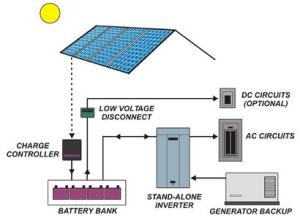There are basically three types of solar PV systems existing today for solar power generation at home, including grid-tie, off-grid and hybrid PV systems. However, as expense and efficiency are concerned, grid-tie and off-grid systems are more popular and most installed around the world. Now let’s compare them with each other and help you decide which system should be suitable for your house.

Grid-Tie System
1. This installation requires your system is connected to the local national (utility) grid.
2. After the connection, the system can feed the electricity (usually extra electricity) it generates to the national grid (this helps it earns money from the grid), and your home can get the electricity from the national grid once your system stops generating electricity at night or in special conditions.
3. The current form your solar panels generates is direct current (DC), which must be converted into alternating current (AC) for home use by going through a PV inverter. The current converted by the inverter must be compatible with the voltage of the local grid.
4. The inverter also needs to be a grid-tie type. An off-grid one cannot be used here.
Off-Grid System

1. Off-grid means the system is disconnected from the local national grid and cannot feed extra electricity to earn money.
2. This installation needs storage batteries, which usually cost a lot of budget.
3. This system is suitable for installation in areas where houses cannot be connected to the national grid or where residents are far away from grids and cities.
4. It needs a charge controller which is used to charge the batteries of the system.
5. The DC from solar panels usually goes to a battery and then to an inverter.
6. This inverter is an off-grid inverter.
1. It can constantly power your house unless the national grid is down and the system meets its special conditions.
2. It can help earn money from the local government by selling extra electricity.
3. It costs less compared with an off-grid system because it doesn’t need expensive batteries.
4. It works more efficiently because its DC doesn’t to go into a battery. This process causes energy loss.
Off-Grid Advantages
1. It can be used in remote areas where national grids cannot reach.
2. It can store extra energy and use it whenever your house needs.
3. It doesn’t need the grid-connecting process.
4. It is totally environmentally friendly.
Current Condition
In comparison, residents around the world prefer a grid-tie system more, and many countries like the UK, the US, the Netherlands and China are encouraging their residents to install this system. But In India, an off-grid system seems to enjoy more welcome because many regions in the country cannot reach national grids.
My wife and I chose the off grid solar system. We were about a quarter of a mile to the grid tie-in and the price to bring the grid to my home was more expensive than a full off grid system. The advantage of being off grid is when the grid goes down, we still have power. The bad about having a solar grid tie-in is when the grid goes down even during a sunny day, your home is shut off too as a safety feature to protect line-workers attempting to restore power.
If you want to learn more about off grid systems, we are posting about our lifestyle choice at https://livingasustainabledream.wordpress.com
LikeLike
Thanks for sharing your story. I appreciate it.
LikeLiked by 1 person